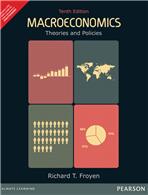Macroeconomics: Theories and Policies, 10/e

|
Author(s):
Author:
Richard T. Froyen
- ISBN:9789332518322
- 10 Digit ISBN:9332518327
-
Price:Rs. 960.00
- Pages:390
- Imprint:Pearson Education
- Binding:Paperback
- Status:Available
-
|
Macroeconomics traces the history, evolution, and challenges of Keynesian economics, presenting a comprehensive, detailed, and unbiased view of modern macroeconomic theory.
Table of Content
PART ONE: INTRODUCTION AND MEASUREMENT
Chapter 1: Introduction
PART TWO: CLASSICAL ECONOMICS AND THE KEYNESIAN REVOLUTION
Chapter 2: Classical Macroeconomics (I): Equilibrium Output and Employment
Chapter 3: Classical Macroeconomics (II): Money, Prices, and Interest
Chapter 4: The Keynesian System (I):The Role of Aggregate Demand
Chapter 5: The Keynesian System (II): Money, Interest, and Income
Chapter 6: The Keynesian System (III): Policy Effects in the IS—LM Model
Chapter 7: The Keynesian System (IV): Aggregate Supply and Demand
PART THREE: MACROECONOMIC THEORY AFTER KEYNES
Chapter 8: The Monetarist Counterrevolution
Chapter 9: Output, Inflation, and Unemployment: Alternative Views
Chapter 10: New Classical Economics
Chapter 11: Real Business Cycles and New Keynesian Economics
Chapter 12: Macroeconomic Models :A Summary
PART FOUR: OPEN ECONOMY MACROECONOMICS
Chapter 13: Exchange Rates and the International Monetary System
Chapter 14: Monetary and Fiscal Policy in the Open Economy
PART FIVE: ECONOMIC POLICY
Chapter 15: Optimal Monetary Policy
Chapter 16: Fiscal Policy
PART SIX: ECONOMIC GROWTH
Chapter 17: Policies for Intermediate-Run Growth
Chapter 18: Long-Run Economic Growth: Origins of the Wealth of Nations
|
Salient Features
• Major theories are presented and compared.
• Important agreements and differences are discussed.
• Demonstrations of the controversies are presented, which center on well-defined theoretical differences.
• Providing an up-to-date summary of the Keynesian position, including research that has come to be called the new Keynesian economics.
• Offering a detailed analysis of challenges to the Keynesian position.
• Several new additions have been added which include topics on monetary policy and economic growth:
• Greater emphasis has been placed on interest rates and on inflation targeting strategies, with less of an emphasis on money.
• The chapter on long-run growth has also been moved out of Part II and placed with the chapter on intermediate growth.
• Both the neo-classical growth model and recent models of endogenous growth are discussed as well.
|
|
|
|
|